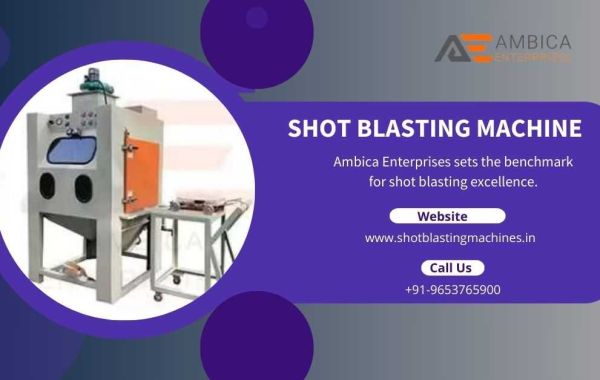What is a Shot Blasting Machine?
A shot blasting machine is a mechanical device designed to propel abrasive materials, such as steel shots, grits, or sand, at high velocities onto a surface. The process involves forcibly propelling abrasive media against a workpiece's surface to remove contaminants, scale, rust, paint, or other imperfections. Shot blasting is a highly effective method for surface preparation, cleaning, and finishing across a wide range of materials, including metals, concrete, wood, and composites.
How Does a Shot Blasting Machine Work?
The basic principle behind shot blasting machines is relatively simple yet highly effective. The machine comprises several key components:
Blasting Chamber: This is the enclosure where the blasting operation takes place. It contains the workpiece and serves as a containment area for the abrasive media.
Abrasive Media: Commonly used abrasive media include steel shots, grits (such as aluminum oxide or silicon carbide), and sometimes even non-abrasive materials like plastic beads or walnut shells, depending on the application requirements.
Blast Wheel or Nozzle: This component is responsible for propelling the abrasive media at high speeds onto the surface of the workpiece. Blast wheels are commonly used in larger industrial shot blasting machines, while smaller handheld or portable units may utilize nozzles powered by compressed air.
Dust Collector: Shot blasting generates a significant amount of dust and debris. A dust collector or recovery system is employed to capture and remove these particles, ensuring a clean working environment and preventing environmental contamination.
The operation of a shot blasting machine typically involves the following steps:
Loading: The workpiece is loaded into the blasting chamber, either manually or using automated systems.
Abrasive Propulsion: The abrasive media, contained either in a hopper or a storage tank, are fed into the blasting system. They are then propelled at high speeds onto the surface of the workpiece by the blast wheel or nozzle.
Impact and Abrasion: Upon impact with the surface, the abrasive media dislodge contaminants, scale, or coatings through a combination of abrasion and kinetic energy transfer.
Separation and Recovery: After the blasting process, the spent abrasive media, along with the removed debris, are collected and separated. The reusable abrasive media are then recycled for future use, while the waste material is disposed of appropriately.
Also Check - Automatic Sand Blasting Machine
Applications of Shot Blasting Machines
Shot blasting machines find widespread applications across various industries, including:
Surface Preparation: Shot blasting is commonly used to prepare surfaces for subsequent processes such as painting, coating, welding, or bonding. By removing contaminants and creating a clean, textured surface, shot blasting improves adhesion and enhances the longevity of surface treatments.
Cleaning and Descaling: In industries like automotive, aerospace, and manufacturing, shot blasting is employed to clean and descale metal components, removing rust, scale, and oxidation layers to restore their original surface condition.
Deburring and Deflashing: Shot blasting effectively removes burrs, sharp edges, and flash from machined or cast parts, ensuring dimensional accuracy and improving the overall quality of the components.
Peening: Shot peening is a specialized application wherein the controlled impact of abrasive media induces compressive stresses on the surface of metal parts. This process improves fatigue resistance, strengthens components, and mitigates the risk of stress corrosion cracking.
Concrete and Stone Treatment: Shot blasting is utilized in the construction industry to prepare concrete surfaces for overlays, coatings, or repairs. It also provides an effective method for exposing aggregate in decorative concrete applications.
Shipbuilding and Marine Maintenance: Shot blasting is essential in shipyards for cleaning and preparing ship hulls, decks, and other marine structures, helping to prevent corrosion and prolong service life.
Also Check - Shot Blasting Machine Manufacturer
Significance in Modern Industries
The widespread adoption of shot blasting machines can be attributed to several key advantages they offer:
Efficiency: Shot blasting is a highly efficient process that can rapidly clean and prepare surfaces, leading to increased productivity and shorter production cycles.
Precision: The ability to control parameters such as abrasive type, size, velocity, and angle of impact allows for precise surface treatment tailored to specific requirements.
Cost-Effectiveness: By reducing manual labor and minimizing material waste, shot blasting machines offer long-term cost savings and improved profitability for businesses.
Environmental Friendliness: Shot blasting produces minimal hazardous waste compared to alternative methods such as chemical stripping or abrasive blasting, making it a more environmentally sustainable choice.
Quality Assurance: Consistent and uniform surface treatment achieved through shot blasting enhances product quality, reliability, and performance, ultimately contributing to customer satisfaction and brand reputation.
In conclusion, shot blasting machines represent a cornerstone technology in surface preparation, cleaning, and finishing processes across diverse industries. Their versatility, efficiency, and effectiveness make them indispensable tools for achieving desired surface characteristics and meeting stringent quality standards. As industries continue to evolve and demand higher levels of precision and productivity, the role of shot blasting machines will only become more prominent in shaping the manufacturing landscape of the future.







